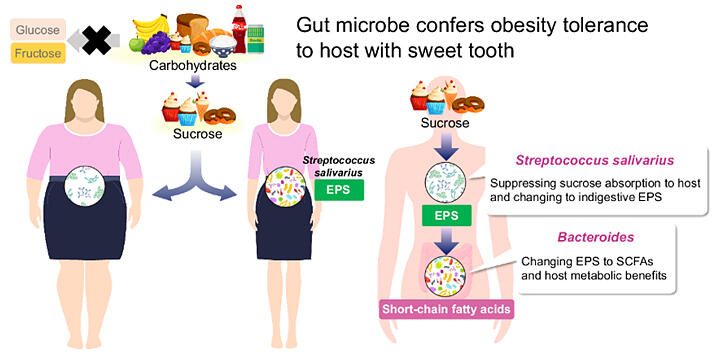While high-fat and high-sugar foods like cakes are delicious, they increase the risk of obesity and diabetes. The main cause is excessive intake of sucrose (sugar), making the development of prevention and treatment methods for obesity and diabetes an urgent matter. Professor Ikuo Kimura's research team at the Graduate School of Biostudies, Kyoto University, previously revealed that "exopolysaccharides (EPS)" produced by lactic acid bacteria used in making kimchi have beneficial effects on health.
In this study, the team analyzed fecal samples from approximately 500 healthy individuals and patients with obesity to search for EPS-producing bacteria from human gut microbiota. As a result, they discovered the gut bacterium " StreptococcuS. salivarius (S. salivarius)," which suppresses sucrose-induced obesity. The EPS made by this gut bacterium from sucrose is a substance similar to indigestible dietary fiber, and the team found that the specific gut bacteria that can utilize this EPS proliferate, leading to an increase in short-chain fatty acids. These improve the intestinal environment and help suppress rapid rises in blood glucose levels.
Next, in experiments with obese mice, consuming EPS suppressed weight gain and improved blood glucose levels. However, this effect disappeared in mice unable to recognize short-chain fatty acids. This indicates that short-chain fatty acids produced by gut bacteria are involved in improving metabolic function. Additionally, experiments introducing gut bacteria, including S. salivarius, into germ-free mice showed suppressed weight gain compared to mice unable to produce EPS, increased short-chain fatty acids, and improved blood glucose levels.
The discovery of gut bacteria that suppress obesity in people with a sweet tooth has revealed a series of mechanisms that prevent sucrose-induced obesity. This research finding is expected to be applied toward the development of new prevention and treatment methods for obesity and diabetes using metabolites derived from gut bacteria.
Mechanism for preventing sucrose-induced obesity





